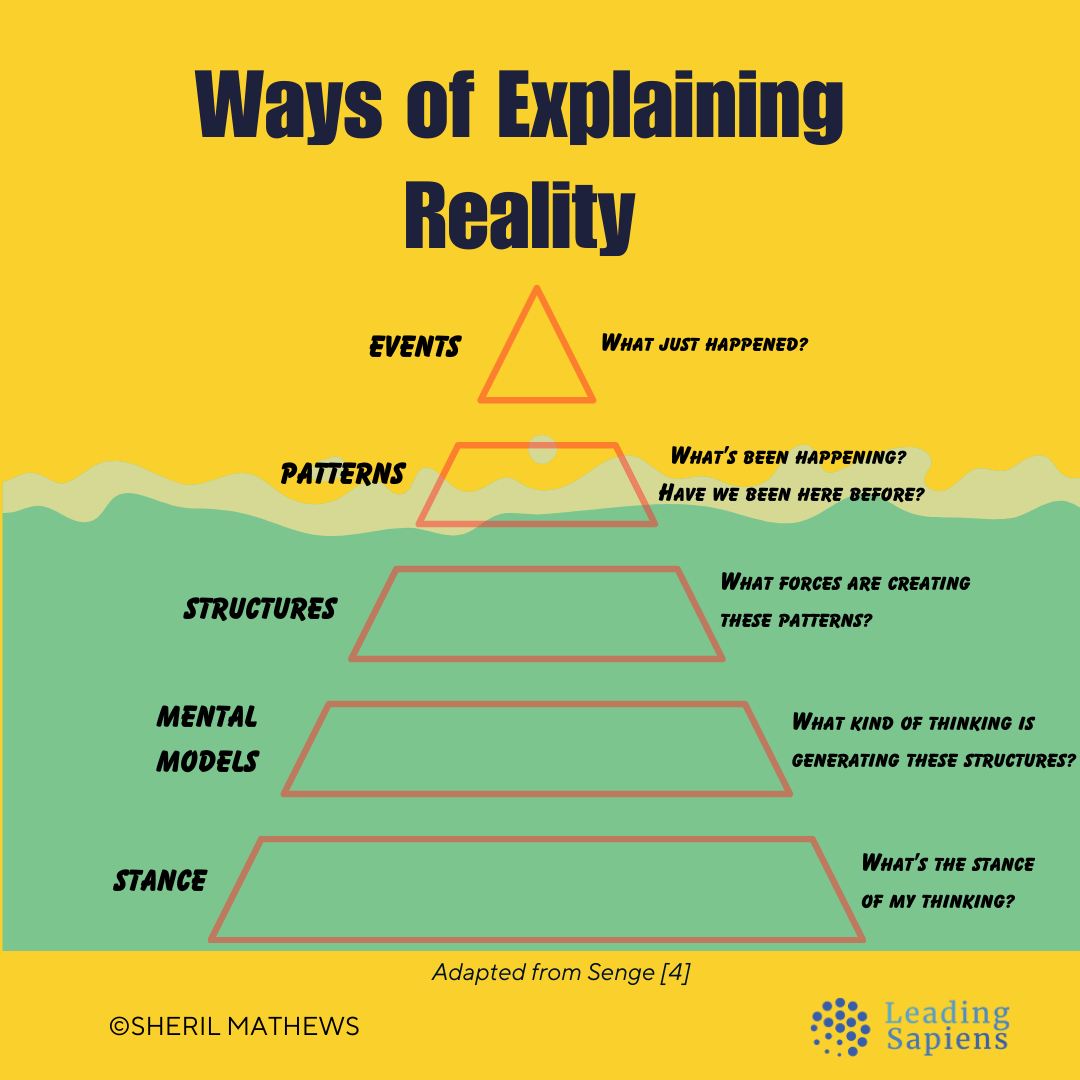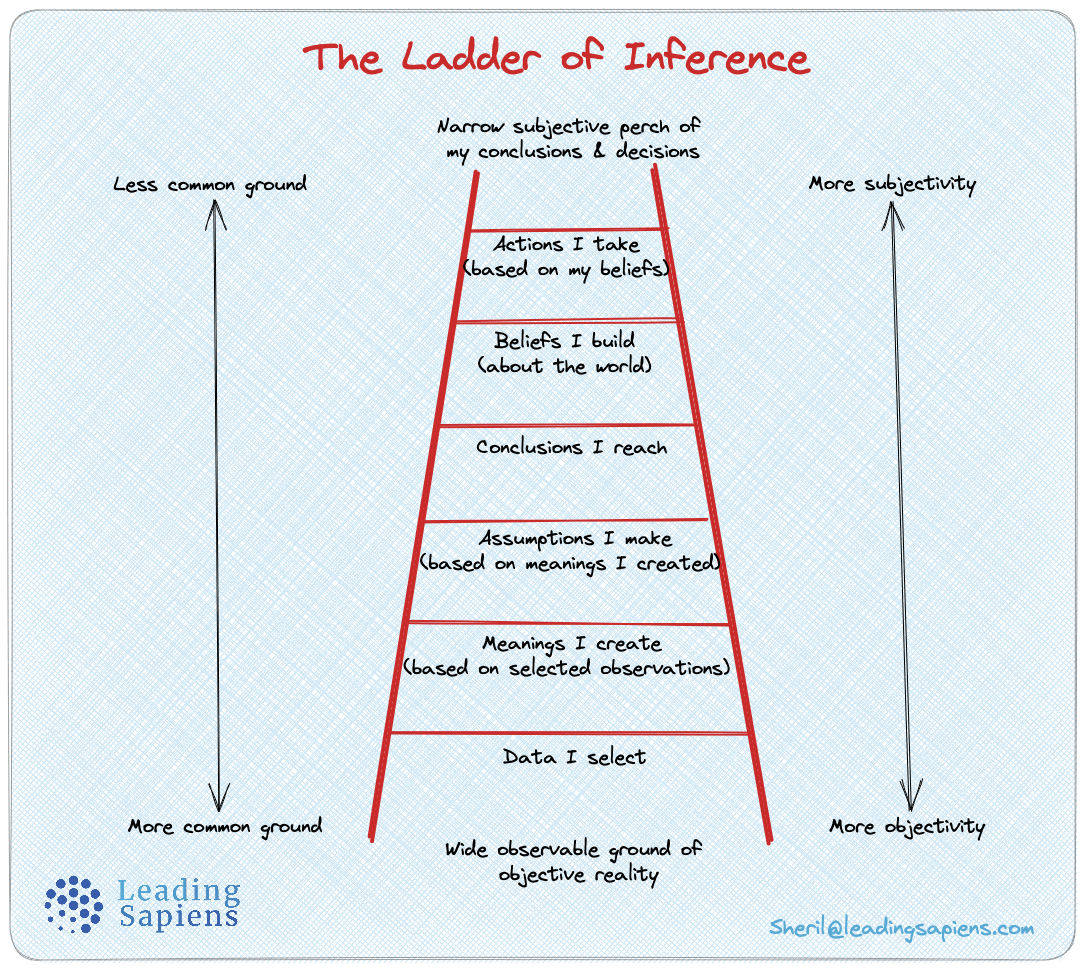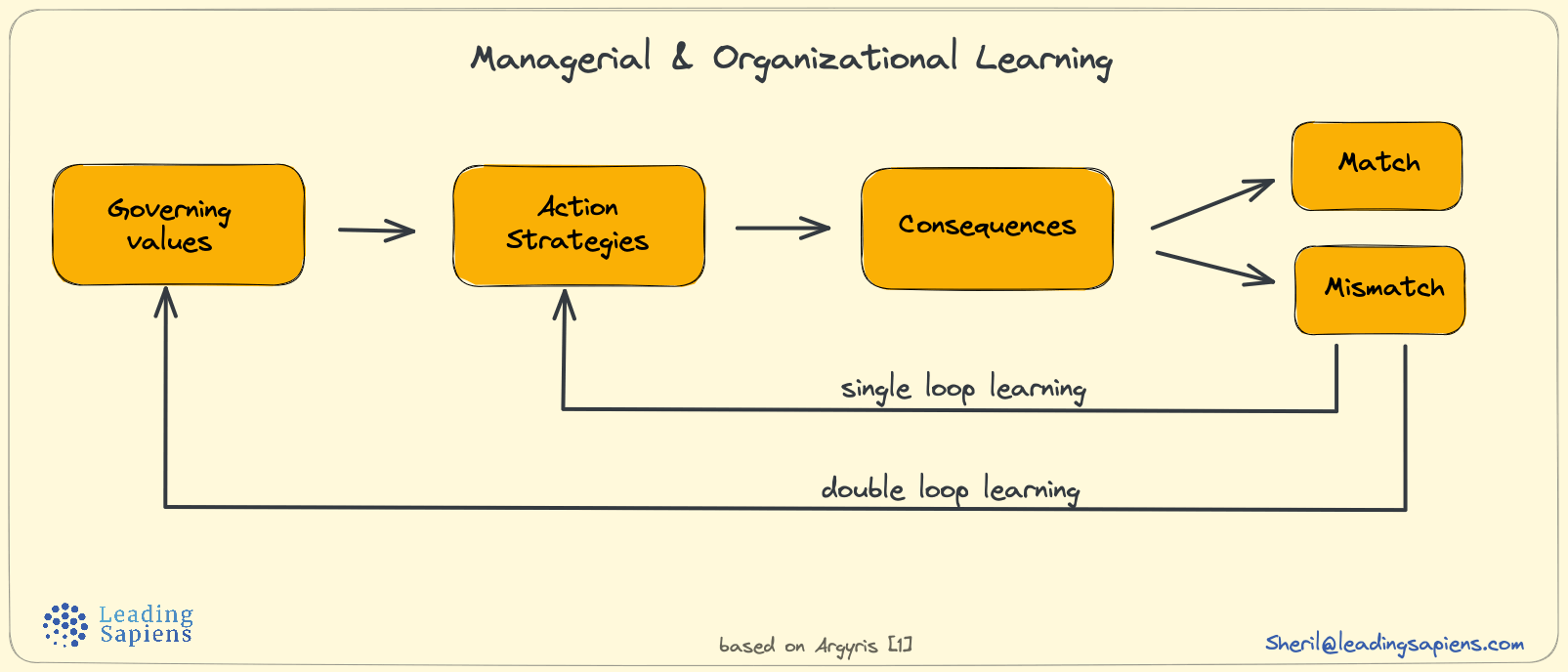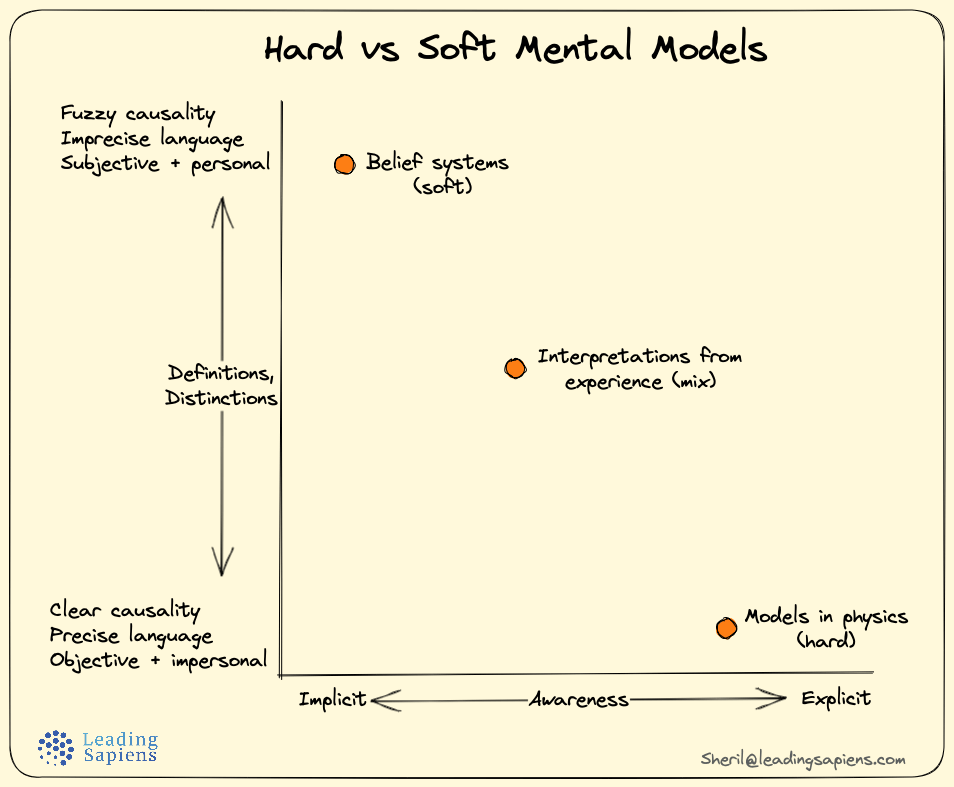The systems thinking iceberg is a useful thinking model for leaders when dealing with intractable problems that never seem to go away. Part of the challenge is what the model calls “events” — surface level issues that are constantly on your radar — which are essentially fire-fighting, but that never really address the real causes.
We'll look at the different levels of the iceberg and how leaders can think better using this tool.
Organizations as systems
So, what is a system? A system is a set of things – people, cells, molecules, or whatever – interconnected in such a way that they produce their own pattern of behavior over time.
— Donella H. Meadows
Clearly, organizations are essentially a big system of systems. And the people within the organization not only work inside this system but make up the system itself.
Unfortunately, many leaders forget this basic fact of organizational life. We are as much affected by the systems and structures that surround us, as much as we affect and change the systems themselves.
A fundamental principle of system dynamics states that the structure of the system gives rise to its behavior. However, people have a strong tendency to attribute the behavior of others to dispositional rather than situational factors, that is, to character and especially character flaws rather than the system in which these people are acting.
… In complex systems different people placed in the same structure tend to behave in similar ways. When we attribute behavior to personality we lose sight of how the structure of the system shaped our choices. The attribution of behavior to individuals and special circumstances rather than system structure diverts our attention from the high leverage points where redesigning the system or governing policy can have significant, sustained, beneficial effects on performance.
...When we attribute behavior to people rather than system structure the focus of management becomes scapegoating and blame rather than the design of organizations in which ordinary people can achieve extraordinary results.
— John D. Sterman [5]
Leaders have to look at situations not only from different angles but also at different structural levels from a systems perspective. How can we get better at thinking about system structures?
This is where the systems thinking iceberg model is a useful tool to both shift perspective and gain some much needed insight.
The systems thinking iceberg
The systems thinking iceberg model delineates “reality” into the essential layers of events, patterns, structures, mental models, and ultimately stance.

(1) Events
- The events level is where most of us operate daily and where we usually focus all our efforts. These are immediate visible effects that are smaller manifestations of a much larger reality.
- They demand immediate attention, but our reactions tend to be insufficient fixes that do not solve long term issues. They do however tend to be convenient and don't require double-loop learning or second-order thinking.
- We are wired at the evolutionary level to feed on events. In contrast, long-term thinking is an acquired practice. The world conspires to keep us thinking at the event level. But the most leveraged actions can be found at the deeper levels of the pyramid.
(2) Patterns
- At this level, we look for past events that might be similar. It involves identifying recurring trends, cycles, or behaviors that emerge over time. They are essentially events but viewed on a longer timeline.
- Patterns provide more context and insight into broader dynamics and relationships beyond isolated events. They reveal underlying systemic issues that may not be immediately apparent.
- Identifying and analyzing patterns is crucial for understanding the interconnected nature of systems. This in turn helps in anticipating and responding to emerging trends more proactively.
(3) Structures
- This level refers to the underlying systems, processes, and designs that shape behaviors and outcomes.
- Structures reinforce patterns of behavior, create silos, or incentivize short-term thinking. These are often deeply embedded and hard to identify and change.
- Addressing issues at this level requires redesigning processes, restructuring roles and responsibilities, and realigning systems to better support desired outcomes.
(4) Mental Models
- These are the deeply held beliefs, assumptions, and mindsets that influence how we perceive reality, make decisions, and take action. These mental models act as filters through which we interpret information and shape our understanding of situations.
- They are deeply ingrained at a subconscious level and can be challenging to surface and question. But, left unexamined, these models lead to blind spots, biases, and flawed decision-making.
(5) Stance
- This is the deepest level of the iceberg from which everything else flows. It's made up of the core values, principles, and worldviews that guide an organization or person.
- Stance reflects the "why" behind actions and decisions, rather than just the "what" or "how."
- This level shapes the overall direction, priorities, and guiding principles that ultimately inform everything else.
By understanding the deeper levels of the iceberg model, we can better identify and address the root causes of systemic issues, rather than merely treating surface-level symptoms. It requires a willingness to question long-held assumptions, redesign structures, and potentially reassess fundamental frameworks.
A systems thinking iceberg example
At the visible, event level, it might be key employees leaving at an alarming rate.
Patterns level
- Consistent failure to promote from within, with external hires being favored for leadership roles.
- Lack of competitive compensation and benefits packages.
- Minimal opportunities for professional development and career growth.
Structural level
- Rigid hierarchies that limit upward mobility.
- Outdated performance evaluation and promotion criteria.
- Siloed departments with little cross-functional collaboration.
Mental Models level
- Belief that external hires bring fresh perspectives and are more valuable than internal talent.
- Assumption that employees are primarily motivated by financial compensation.
- Mindset that prioritizes short-term cost-cutting over long-term talent investment.
Stance Level
- Primary focus on profitability, but at the expense of employee well-being.
- Culture that values conformity and obedience over innovation and risk-taking.
Addressing the issue effectively will require an approach that not only implements retention strategies (events), but also revamps outdated processes (structure), challenges entrenched beliefs and assumptions (mental models), and reassesses core values and culture (stance).
How leaders can use the systems thinking iceberg
Event oriented responding comes naturally to us. The real work is to develop a practice of thinking that looks beyond events and into the structures and models that lead to those events.
From answers to questions

One way to build this thinking practice is to move from seeking answers to focusing on questions at each level:
- What makes you say that? (mental models)
- What might be causing this behavior? (structures)
- How are the forces influencing each other? (structures)
- What fundamental aspects need to be changed to alter patterns? (structures)
- What are some unintended consequences? (pattern)
- What's been happening? Have we been here or someplace similar before? (pattern)
Essentially, by focusing on questions instead of answers you’re actively shaping the context rather than getting lost in the details of the problem.
Future-based thinking
The standard approach is to start with current problems and then work your way to the deeper structures that are causing them. However, the iceberg model is a useful tool to practice future-based thinking as well.
Your leverage is maximum at the deepest levels of the iceberg where actions are not only driven by the future you want to create, but also more in our control. In future-based thinking, you start at the bottom of the iceberg and work your way up leading to the real-time events you aim to create.

The difference here is subtle.
When we operate only at the events level, the constant reaction mode means the future is essentially an extension of the past and present. In contrast, operating and designing actions from the stance and mental model level means you’re acting proactively into a very different future instead of simply an extension.
You’re essentially shifting perspective and moving into a higher plane of thinking and operating. It's the difference between being pulled by the future vs being pushed by the past.

The following questions can help with starting at the deepest levels of the iceberg:
- What is the ideal future state?
- What's the stance required to enable that vision?
- What are the mental models, assumptions, and beliefs required to support this stance and vision?
- What structures are needed to support this future?
- What patterns and events will tell us we’re indeed on track?
Balancing the levels on the iceberg
As a practice, the key challenge is finding the balance between the different levels of the iceberg based on what we find ourselves in.
Too much focus on events and you don't have any perspective, or long-term sustainability. Too much focus on stance, and there's not enough action happening on the ground.
The leadership challenge is to get better at balancing between the extremes.

Related reading
Below are some additional articles that are related to systems thinking and the iceberg model:
- The ladder of inference model which shows how we jump to conclusions and how to make better decisions.

- Double loop learning, a related and essential mechanism for leaders to become better thinkers.

- Hidden mental models that are different from the standard ones being popularized.

- The laws of systems thinking.
- Problem-setting is different from problem-solving.
- How to think long-term about careers.
- Peter Drucker on strategic time-frames.
- Why reflection is critical to effective leadership.
Sources
- Systems Thinking Basics by Virginia Anderson, Lauren Johnson
- The Fifth Discipline by Peter Senge
- The Fifth Disicipline Fieldbook by Peter Senge, Art Kleiner, Richard Ross, Charlotte Robert, Bryan Smith
- Necessary Revolution by Peter Senge
- Business Dynamics by John D Sterman



